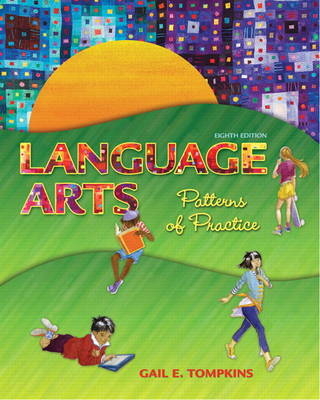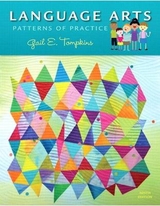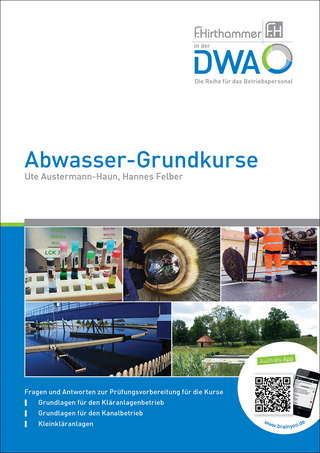
Language Arts
Pearson (Verlag)
978-0-13-268575-7 (ISBN)
- Titel erscheint in neuer Auflage
- Artikel merken
Gail Tompkins I’m a teacher, first and foremost. I began my career as a first-grade teacher in Virginia in the 1970s. I remember one first grader who cried as the first day of school was ending. When I tried to comfort him, he sobbed accusingly, “I came to first grade to learn to read and write and you forgot to teach me.” The next day, I taught that child and his classmates to read and write! We made a small patterned book about one of the stuffed animals in the classroom. I wrote some of the words and the students supplied the others, and I duplicated copies of the book for each child. We practiced reading it until everyone memorized our little book. The children proudly took their books home to read to their parents. I’ve never forgotten that child’s comment and what it taught me: Teachers must understand their students and meet their expectations. My first few years of teaching left me with more questions than answers, and I wanted to become a more effective teacher so I started taking graduate courses. In time I earned a master’s degree and then a doctorate in Reading/Language Arts, both from Virginia Tech. Through my graduate studies, I learned a lot of answers, but more importantly, I learned to keep on asking questions. Then I began teaching at the university level. First I taught at Miami University in Ohio, then at the University of Oklahoma, and finally at California State University, Fresno. I’ve taught preservice teachers and practicing teachers working on master’s degrees, and I’ve directed doctoral dissertations. I’ve received awards for my teaching, including the Provost’s Award for Excellence in Teaching at California State University, Fresno, and I was inducted into the California Reading Association’s Reading Hall of Fame. Throughout the years, my students have taught me as much as I taught them. I’m grateful to all of them for what I’ve learned. I’ve been writing college textbooks for more than 20 years, and I think of the books I write as teaching, too. I’ll be teaching you as you read this text. As I write a book, I try to anticipate the questions you might ask and provide that information. I also include students’ samples so you can see concepts that I’m explaining, and I include lists of trade books that you can refer to as you work with students.
Language Arts: Patterns of Practice 8e Table of Contents
Chapter 1 Learning and the Language Arts 2
Vignette First Graders Apply the Six Language Arts 2
HOW CHILDREN LEARN 5
The Process of Learning 5
Learning Strategies 6
Social Contexts of Learning 7
Implications for Learning Language Arts 7
LANGUAGE LEARNING AND CULTURE 8
The Four Language Systems 8
Academic Language 11
Culturally and Linguistically Diverse Students 11
Critical Literacy 13
Implications for Learning Language Arts 14
HOW STUDENTS LEARN LANGUAGE ARTS 14
A Community of Learners 14
Self-Efficacy 17
The Six Language Arts 18
Language Arts Strategies 20
Communicative Competence 24
Engaging English Learners 24
Summing Up 25
Chapter 2 Teaching and Assessing Language Arts 26
Vignette A Sixth Grade Language Arts Class 26
PATTERNS OF PRACTICE 30
Literature Focus Units 31
Literature Circles 31
Reading and Writing Workshop 33
Thematic Units 37
THE TEACHER’S ROLE 38
Scaffolding Learners 38
Differentiating Instruction 41
Engaging English Learners 42
Teaching Struggling Students 42
Language Arts Standards 44
ASSESSING LEARNING 45
Monitoring Progress 46
Evaluating Learning 48
Implementing Portfolios 49
High-Stakes Assessments 56
Summing Up 57
Chapter 3 Emergent Literacy 58
Vignette K–1 Students Read and Write 58
FOSTERING CHILDREN’S INTEREST IN WRITTEN LANGUAGE 62
Written Language Concepts 62
Alphabet Concepts 64
YOUNG CHILDREN BECOME READERS 74
Shared Reading 74
Language Experience Approach 78
YOUNG CHILDREN LEARN TO WRITE 78
Introducing Young Children to Writing 81
Interactive Writing 81
Minilessons 84
Summing Up 85
Chapter 4 Personal Writing 86
Vignette Seventh Graders Respond to Literature 86
WRITING IN JOURNALS 90
Personal Journals 90
Dialogue Journals 92
Reading Logs 93
Double-Entry Journals 95
Learning Logs 96
Simulated Journals 98
SOCIAL NETWORKING 101
Classroom Blogs 101
Safety Concerns 103
LETTER WRITING 104
Friendly Letters 104
Email Messages 106
Business Letters 107
Simulated Letters 107
TEACHING PERSONAL WRITING 107
Minilessons 108
Mentor Texts 108
Engaging English Learners 110
Assessing Students’ Personal Writing 112
Summing Up 113
Chapter 5 Oral Language: Listening and Talking 114
Vignette Second Graders Read Folktales 114
LISTENING 118
Types of Listening 118
Reading Aloud 122
Persuasion 125
TALK 127
Talking in Small Groups 127
Discussions 128
Oral Reports 133
Interviews 133
Debates 134
TEACHING ORAL LANGUAGE 136
Minilessons 136
Mentor Texts 137
Taking Notes 137
Engaging English Learners 140
Assessing Oral Language 142
Summing Up 143
Chapter 6 Written Language: Reading and Writing 144
Vignette Ms. Kakutani Uses the Reading Process 144
THE READING PROCESS 148
Stage 1: Prereading 148
Stage 2: Reading 149
Stage 3: Responding 151
Stage 4: Exploring 152
Stage 5: Applying 153
Teaching the Reading Process 153
THE WRITING PROCESS 156
Stage 1: Prewriting 157
Stage 2: Drafting 158
Stage 3: Revising 159
Stage 4: Editing 162
Stage 5: Publishing 164
Teaching the Writing Process 166
The Author’s Craft 168
Engaging English Learners 172
Reading and Writing Are Reciprocal Processes 173
Summing Up 175
Chapter 7 Visual Language: Viewing and Visually Representing 176
Vignette Eighth Graders Learn About Irony 176
VISUAL ELEMENTS 181
Color 181
Line 184
Symbols 185
Humor 188
Teaching Visual Language 190
VIEWING 192
Art Appreciation 192
Visual Language in Books 196
VISUALLY REPRESENTING 203
Artistic Representations 203
Graphic Representations 204
Dramatic Representations 204
Summing Up 209
Chapter 8 Building Vocabulary 210
Vignette Eighth Graders Study Words 210
HISTORY OF THE ENGLISH LANGUAGE 213
Old English (A.D. 450–1100) 213
Middle English (1100–1500) 214
Modern English (1500–Present) 215
Learning About Word Histories 215
WORDS AND THEIR MEANINGS 216
Morphological Information 217
Synonyms and Antonyms 219
Homonyms 222
Multiple Meanings 223
Idioms 224
Borrowed Words 225
TEACHING STUDENTS ABOUT WORDS 225
Targeting Words to Teach 228
Word-Learning Strategies 229
Word Walls 230
Word-Study Activities 232
Minilessons 234
Differentiating Instruction 237
Engaging English Learners 238
Assessing Vocabulary Knowledge 240
Summing Up 241
Chapter 9 Comprehending and Composing Stories 242
Vignette Fifth Graders Read a Novel 242
CONCEPT OF STORY 247
Elements of Story Structure 247
Story Genres 256
Narrative Devices 258
Teaching Students About Story Structure 258
Engaging English Learners 263
Assessing Students’ Knowledge About Stories 264
COMPREHENDING STORIES 264
Guided Reading 264
Readers Theatre 265
Responding to Stories 266
Retelling Stories 268
WRITING STORIES 270
Writing Retellings 271
Story Innovations 272
Genre Stories 273
Original Stories 274
Summing Up 275
Chapter 10 Investigating Nonfiction 276
Vignette Kindergartners Learn About Fish 276
NONFICTION BOOKS 281
Expository Text Structures 285
Nonfiction Features 287
Comparing Fiction and Nonfiction Books 287
RESEARCH 289
The Research Process 289
Research Tools 289
Reporting 291
Multigenre Projects 299
Life Stories 301
TEACHING NONFICTION 304
Research Workshop 305
Minilessons 306
Mentor Texts 306
Engaging English Learners 308
Assessing Nonfiction Projects 309
Summing Up 310
Chapter 11 Exploring Poetry 312
Vignette Sixth Graders Participate in Poetry Workshop 312
PLAYING WITH WORDS 316
Laughing With Language 316
Creating Word Pictures 318
Experimenting With Rhyme 318
THE POETRY GENRE 320
Poems Students Read 320
Poems Students Write 320
Poetic Devices 333
TEACHING POETRY 335
How to Read Poems 335
Teaching Students to Write Poems 340
Minilessons 342
Mentor Texts 344
Engaging English Learners 344
Assessing Poetry 345
Summing Up 347
Chapter 12 Learning to Spell Conventionally 348
Vignette Fourth Graders Study Spelling Words 348
SPELLING DEVELOPMENT 352
Invented Spelling 353
Stages of Spelling Development 353
Analyzing Students’ Spelling Development 356
TEACHING SPELLING 360
Spelling Strategies 360
Components of the Spelling Program 361
Minilessons 367
Weekly Spelling Tests 367
Engaging English Learners 371
Assessing Students’ Spelling Development 372
Summing Up 373
Chapter 13 Language Tools: Grammar and Handwriting 374
Vignette Fifth Graders Learn Grammar Through Literature 374
GRAMMAR 379
Grammar Concepts 379
Teaching Grammar 382
Engaging English Learners 390
Assessing Students’ Knowledge About Grammar 390
HANDWRITING 391
Handwriting Forms 391
Students’ Handwriting Development 392
Teaching Handwriting 393
Summing Up 399
Chapter 14 Putting It All Together 400
Vignette First Graders Study the Solar System 400
LITERATURE FOCUS UNITS 405
How to Develop a Literature Focus Unit 405
A Primary Grade Unit on The Mitten 409
An Upper Grade Unit on The Giver 411
LITERATURE CIRCLES 411
How to Organize Literature Circles 411
READING AND WRITING WORKSHOP 414
Establishing a Workshop Environment 415
How to Set Up a Reading Workshop 415
How to Set Up a Writing Workshop 417
THEMATIC UNITS 420
How to Develop a Thematic Unit 421
Using Content-Area Textbooks 423
A Fourth Grade Unit on Flight 425
Summing Up 427
Special Features Table of Contents
Minilesson
Mr. Voss’s Kindergartners Learn to Predict 85
Mr. Rinaldi’s Eighth Graders Write Simulated Letters 109
Ms. Shapiro Teaches Her Second Graders About Sustaining Conversations 138
Ms. Yarborough Introduces Revising to Third Graders 168
Mrs. Monroe Teaches Her Sixth Graders About Word Histories 236
Mrs. Levin’s Second Graders Learn About Theme 260
Mr. Uchida Teaches His Fifth Graders How to Write Data Charts 307
Mr. Johnston Teaches His Third Graders to Read Poems Expressively 343
Mrs. Hamilton Teaches the “Think It Out” Strategy 369
Ms. Thomas Teaches Manuscript Letter Formation 395
Step-by-Step
Minilessons 31
Think-Alouds 40
Rubrics 51
Shared Reading 75
Language Experience Approach 79
Interactive Writing 83
Classroom Blogs 102
Interactive Read-Alouds 123
Grand Conversations 130
Hot Seat 135
Revising Groups 160
Interpreting Political Cartoons 190
Viewing Images 193
Story Boards 199
Process Drama 207
Word Learning 229
Word Walls 231
Sketch-to-Stretch 256
Guided Reading 266
Retelling Stories 269
The Research Process 290
Cubing 294
Choral Reading 338
Gallery Walks 342
Making Words 366
Word Ladders 368
Anticipation Guides 424
Integrating Technology
Literacy and the Internet 23
Online Assessment Tools 55
Electronic and Interactive Media 73
Technology-Supported Activities 38
Publishing Writing Online 166
Digital Tools for Viewing and Visually Representing 191
Digital Tools for Teaching Vocabulary 236
Digital Tools for Reading and Writing Stories 261
Nonfiction Applications of Digital Technology 308
Online Resources for Writing and Learning About Poetry 344
Keyboarding 397
Common Core State Standards
Language Arts Standards 45
Emergent Literacy 62
Personal Writing 108
Oral Language 136
Written Language 147
Visual Language 190
Vocabulary 226
Stories 259
Nonfiction 306
Poetry 317
Spelling 360
Grammar 384
| Erscheint lt. Verlag | 9.3.2012 |
|---|---|
| Sprache | englisch |
| Maße | 203 x 254 mm |
| Gewicht | 826 g |
| Themenwelt | Schulbuch / Wörterbuch |
| Sozialwissenschaften ► Pädagogik ► Berufspädagogik | |
| Sozialwissenschaften ► Pädagogik ► Schulpädagogik / Grundschule | |
| ISBN-10 | 0-13-268575-2 / 0132685752 |
| ISBN-13 | 978-0-13-268575-7 / 9780132685757 |
| Zustand | Neuware |
| Haben Sie eine Frage zum Produkt? |
aus dem Bereich



